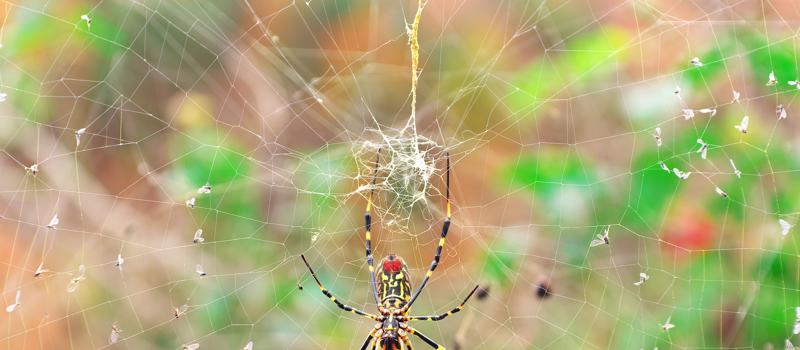Meet the Joro Spider
Posted by Mosquito Squad
January 27, 2022

Over the last two years, it seems as though there has been an increase in reports of invasive pests making their presence known across the United States. From spotted lanternflies in the north to murder hornets in the west, the pest landscape across America is changing.
The latest pest to make headlines is popping up in the south - the Joro spider. The spider originated from southeast Asia but are thought to have made their way to America via a shipping container. The Joro spider first appeared in Georgia around 2014, but in 2021 their population within the state seemed to inflate. The spider garnered media attention across the country while irritating Georgia residents across the state.
One reason for this irritation is the web they weave. The Joro spider falls into the category of "orb-weaving spiders,” which are known for building intricate webs to catch prey. Their webs have a golden hue and are quite large – in some instances, measuring up to 10 feet deep!
Appearance
The Joro spider, Trichonephila clavate, is easily recognizable thanks to its size and distinct markings. An adult spider can grow to be between 3-4 inches, spanning the width of the palm of your hand when its legs are fully stretched out. It has distinct black and yellow markings, which sometimes gets it mistaken for a banana spider. However, you can know for sure that you’re looking at a Joro spider by the distinct red mark on the underside of its belly.
Presence
The Joro spider traditionally called warm, humid climates home. Knowing this, it’s no surprise to learn that the spider has thrived in the state of Georgia. While their population is expanding there, the Joro spider is also starting to pop up in other southern states that offer warm temperatures and high humidity. They have been spotted in:
- Georgia
- South Carolina
- Alabama
- Tennessee
While entomologists and experts are not exactly sure why their population has grown so much within the last year, they do know the Joro spider isn’t going anywhere. As long as conditions are favorable, it’s reasonable to believe that we will continue to see them spread across the southern United States.
Threat
While their large size and bright coloring may seem ominous, the Joro spider does not pose a direct threat to humans. Like many spiders, the Joro spider possesses a venom that they use to attack their prey. Unless a human is allergic to that venom, it's unlikely major harm will be done if a bite is experienced.
Impact
A species gets classified as invasive when it is exotic to the environment it’s found in, and is likely to cause environmental or economic harm or harm to human health. Some entomologists acknowledge the positives of the emerging Joro spider population – they feed on a variety of insects, including stink bugs, which can severely damage crops.
However, the entomological community generally agrees that more time and research are needed to fully assess their impact. Given that this is not the Joro spider’s habitat, we should be cautiously optimistic about the potential long-term effects on local ecosystems.
Finding it difficult to enjoy your yard without walking into a (Joro) spider web? Contact your local Mosquito Squad to ask about specialty services!
